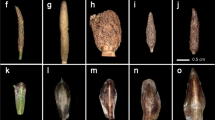Abstract
Chromosome counts and morphological measurements were carried out onEleocharis uniglumis s. 1. samples from nine populations in Slovakia, Hungary, Austria and Croatia. A high polyploidEleocharis uniglumis s.l. (2n=71–88) was found on halophilous sites: in western Slovakia (Svätojurský Šúr near Bratislava; 2n=71–78), on the Hungarian and Austrian shores of Lake Neusiedlersee (Hungary: Hidegség; Austria: Tadten, St. Andrä am Zicksee; 2n=71–82), and on the Croatian island of Krk, (shores of Lake Jezero and Lake Ponikve; 2n=80–88). These high polyploid populations have the same ploidy level asE. uniglumis subsp.sterneri, described as endemic to the islands of Öland and Gotland. Morphological similarities between the high polyploids and subsp.sterneri were found both in quantitative features correlated with ploidy level (stomatal length, anther length and fertile glume length) and in other characters (number of perianth bristles, broad sterile glume margins). Differences were detected in the receptacle density and in the length of perianth bristles compared to the length of the achene. Intermediate somatic chromosome numbers 2n=60–70, corresponding to Scandinavian hybrids betweenE. uniglumis subsp.uniglumis andE. uniglumis subsp.sterneri, were found near Neusiedlersee (Austria: Apetlon, Tadten; Hungary: Hidegség, Hegykö). These (karyologically intermediate) plants have intermediate stomatal lengths. In other features they are similar to the Central European high polyploids.Eleocharis uniglumis subsp.uniglumis (2n=46) was found here as well (Hungary: Fertőrákos).
Similar content being viewed by others
References
Arohonka T. (1982): Chromosome counts of vascular plants of the island Seili in Nauvo, SW Finland.Turun Yliopiston Biol.-Laitok. Julkaisuja 3: 1–12.
Battaglia E. (1954): Assenza di centromero localizzato inHeleocharis uniglumis(Link) Schult. (Absence of localized centromere inHeleocharis uniglumis (Link Schult.).Caryologia 6: 319–332.
Casper S.J. &Krausch H.-D. (1980):Pteridophyta undAnthophyta I. In:Ettl H., Gerloff J. &Heynig H. (eds.),Süsswasserflora von Mitteleuropa 23, Gustav Fischer Verlag, Jena.
Darlington C.D. &Wylie A.P. (1955):Chromosome atlas of flowering plants. George Allen & Unwin, London.
Egorova T.B. (1981): GenerisEleocharis R.BR. (Cyperaceae) florae URSS systema et conspectus.Novosti Sist. Vyssh. Rast. 18: 95–124.
Guaglianone E.R. &Ueno O. (1990): A disjunct species inEleocharis (Cyperaceae).Darwiniana 30: 223–229.
Håkansson A. (1928): Die Chromosomen einiger Scirpoideen.Hereditas 10: 277–292.
Löve Á. (1981): IOPB chromosome number report. LXXIII.Taxon 30: 829–861.
Löve Á. &Löve D. (1956): Cytotaxonomical conspectus of the Icelandic flora.Acta Horti Gotob. 20: 65–290.
Löve Á. &Löve D. (1975: Nomenclatural adjustments in some European Monocotyledons.Folia Geobot. Phytotax. 10: 271–276.
Otzen D. (1962): Chromosome studies in the genusScirpus L., sectionSchoenoplectusBenth. etHook., in the Netherlands.Acta Bot. Neerl. 11: 37–46.
Piech K. (1927): Studia cytologiczne na rodzajemScirpus (Cytological studies of genusScirpus).Rozpr. Wydz. Mat. — Przyr. Polsk. Akad. Umjetn., Dzial A/B, Nauki Mat.-Fiz. Biol. 63–66: 93–151.
Piech K. (1928a): Zytologische Studien an der GattungScirpus.Bull. Int. Acad. Polon. Sci., Ser. B. 1928: 1–43.
Piech K. (1928b): Über die Entstehung der generativen Zelle beiScirpus uniglumisLink durch “freie Zellbildung”.Planta 6: 96–117.
Pogan E. (1972): Studies inEleocharisR.Br. I. Chromosome numbers ofE. palustris (L.) R. & S. andE. uniglumis (Link.)Schult.Acta Biol. Cracov., Ser. Bot. 15: 69–75.
Pogan E., Wcislo H. &Jankun A. et al. (1980): Further studies in chromosome numbers of Polish Angiosperms. Part XIII.Acta Biol. Cracov., Ser. Bot. 22: 37–69.
Ridley H.N. (1930):The dispersal of plants throughout the world. L. Reeve and Company, Ashford.
Saunte L. (1958): Chromosome variation in theHeleocharis palustris-uniglumis complex.Nature 181: 1019–1020.
Schultze-Motel W. (1966):Cyperaceae. In:Hegi G.,Illustrierte Flora von Mitteleuropa 2(1): 1, Ed. 3, Hanser, München, pp. 52–67.
Schuyler A.E. (1977): Chromosome observations on some eastern North AmericanEleocharis (Cyperaceae).Brittonia 29: 129–133.
Sorsa V. (1962): Chromosomenzahlen finnischer Kormophyten. I.Ann. Acad. Sci. Fenn. Ser. A. IV, Biol. 68: 1–13.
Sterner R. (1938): Flora der Insel Öland.Acta Phytogeogr. Suec. 9: 1–169.
Strandhede S.-O. (1958):Eleocharis, subseriesPalustres, i Skandinavien och Finland. Preliminärt meddelande (Eleocharis subseriesPalustres in Scandinavia and Finland. Preliminary communication).Bot. Not. 111: 228–236.
Strandhede S.-O. (1961):Eleocharis Palustres in Scandinavia and Finland. Taxonomical units within the area.Bot. Not. 114: 417–434.
Strandhede S.-O. (1965): Chromosome studies inEleocharis, subser.Palustres. III. Observations on Western European taxa.Opera Bot. 9/2: 1–86.
Strandhede S.-O. (1966): Morphologic variation and taxonomy in EuropeanEleocharis, subser.Palustres.Opera Bot. 10/2: 1–187.
Strandhede S.-O. (1967):Eleocharis, subser.Eleocharis in North America. Taxonomical comments and chromosome numbers.Bot. Not. 120: 355–368.
Strandhede S.-O. &Dahlgren R. (1968): Drawings of Scandinavian plants 11–12.EleocharisR.Br.Bot. Not. 121: 145–152.
Svenson H.K. (1939): Monographic studies in the genusEleocharis — V.Rhodora 41: 1–19, 43–77, 90–110.
Tarnavschi I.T. (1948): Die Chromosomenzahlen der Anthophyten-Flora von Rumänien mit einem Ausblick auf das Polyploidie-Problem.Bull. Jard. Mus. Bot. Univ. Cluj, 28, Suppl. 1: 1–130.
Thiébaud M.-A. (1970): Contribution al’étude caryologique du genreEleocharisR.Br. en Suisse.Candollea 25: 209–219.
Walters S.M. (1949):EleocharisR.Br. (Biological flora of the British Isles).J. Ecol. 37: 192–206.
Walters S.M. (1950):Variation in Eleocharis Palustresagg. Ph.D. Thesis, University of Cambridge, Cambridge.
Walters S.M. (1980):EleocharisR.Br. In:TutinT.G. et al. (eds.),Florea europaea 5, Cambridge University Press, Cambridge, pp. 281–284.
Yurtsev B.A. &Zhukova P.G. (1978): The cytotaxonomical survey of the monocots of the easternmost Chukchi Peninsula.Bot. Zhurn. 63: 1132–1144.
Author information
Authors and Affiliations
Corresponding author
Rights and permissions
About this article
Cite this article
Bureš, P. A high polyploidEleocharis uniglumis S.L. (Cyperaceae) from Central and Southeastern Europe. Folia Geobot 33, 429–439 (1998). https://doi.org/10.1007/BF02803644
Received:
Revised:
Accepted:
Issue Date:
DOI: https://doi.org/10.1007/BF02803644




